It looks like you're using an Ad Blocker.
Please white-list or disable AboveTopSecret.com in your ad-blocking tool.
Thank you.
Some features of ATS will be disabled while you continue to use an ad-blocker.
share:
Moon Fountains and Moon Storms
I created this thread as a reply to Jim Oberg in another thread...
What this was in reference too was the sketches made by Apollo 17 Astronauts of lunar "twilight rays" known as "crepuscular rays". These were first seen by Surveyor but not talked about for some time . My question was why the SKETCHES instead of just snapping what would be a historical and awesome photo.
Here on Earth they look like this... I am sure Phage or someone can explain what causes the effect
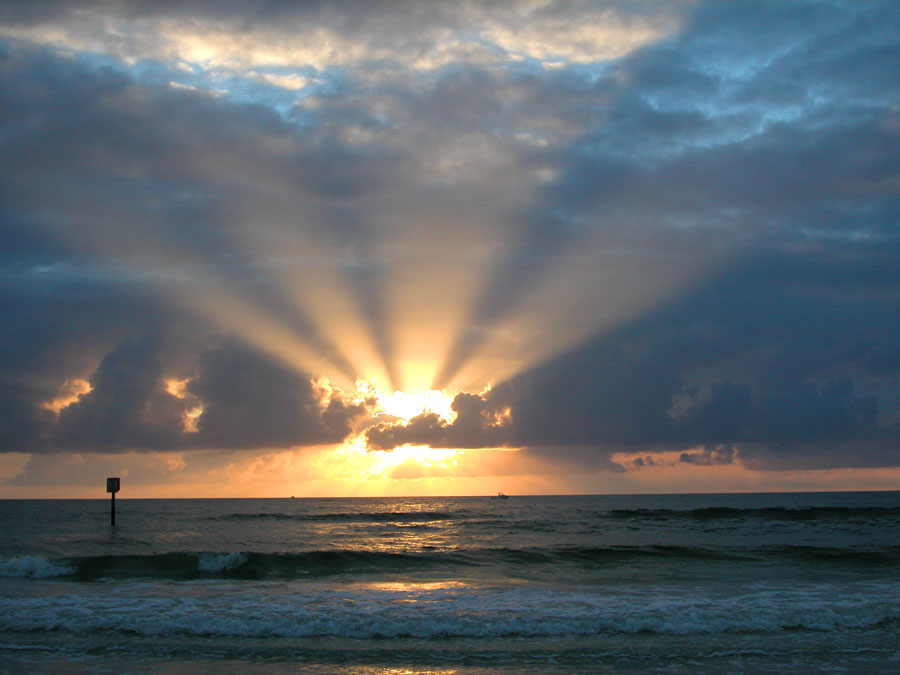
A Little Background
For hundreds of years astronomers have been reporting dust clouds on the Moon and many have reported seeing these rays as well but mostly people call them nutcases and brush it off...
Well NASA has a TLP catalog that has recorded such phenomena since 1540 and especially the glowing crater Aristarchus (but that is another story already covered)
NASA Technical Report TR R-277. was published in July 1968 as a Chronological Catalog of Reported Lunar Events From 1540 to 1966 This is hard to find now but there is a copy available here at Scribd- NASA Technical Report TR R-277
Now we all know there is no atmosphere on the Moon correct? So 'normal' explainations for this phenomena would not do...
Well not to worry... NASA came up with a story to cover this... LEVITATING MOON DUST
Apollo 17
Caption
On the left are lunar "twilight rays" sketched by Apollo 17 astronauts; on the right are terrestrial crepuscular rays photographed by author Trudy E. Bell.
Full sketch
NASA presented this in an article with an interesting title...
NASA Space Science Moon Fountains March 30, 2005
Well how about that?
I wonder if Timothy is any relation to our Martyn?
Anyway then they say THIS
SOOOO Now NASA is saying "a tenuous atmosphere of moving dust particles"
Author: Trudy E. Bell
science.nasa.gov...
A Dynamic Fountain Model for Lunar Dust
by Timothy J. Stubbs, Richard R. Vondrak, and William M. Farrell
LPI-1899 PDF
Although Timothy Stubbs is reluctant at this stage to make a definitive connection between crepuscular rays seen on Earth and the lunar rays sketched by the Apollo 17 astronauts, that very connection was suggested more than two decades ago by astronomers Aden and Marjorie Meinel in their charming book on meteorological optics: Sunsets, Twilights, and Evening Skies (Cambridge University Press, 1983) p. 123-126. Two different pictures of crepuscular rays can be found in Skyscapes, by Trudy E. Bell, League of American Bicyclists magazine, 37 (3): 12-15 (Summer 2001).
Just one of several papers from the early 1970s hypothesizing that the twilight glows photographed by the Surveyor landers and the "lunar rays" seen by the Apollo 17 astronauts were due to suspended lunar dust was
"Evidence for a Lunar Dust Atmosphere from Apollo Orbital Observations" by J. E. McCoy and D. R. Criswell, Abstracts of the Lunar and Planetary Science Conference, volume 5, page 475, (1974). Another was "Surveyor Observations of Lunar Horizon-Glow" by J. J Rennilson and D. R. Criswell, The Moon 10: 121--142 (1974).
Electrostatic levitation of dust is also being studied by the Dusty Plasma Group in the physics department at the University of Colorado.
Alternate routes
Evidence For Lunar Dust Atmosphere From Apollo Orbital Observations
adsabs.harvard.edu...
Alternate route
adsabs.harvard.edu...
CONTINUED.....
I created this thread as a reply to Jim Oberg in another thread...
Originally posted by JimOberg
Zorgon, please don't forget this request....
Originally posted by JimOberg
Originally posted by zorgon
Just like on the Moon... they SKETCHED what the sunset rays looked like yet had that Hassleblad strapped on their chest to point and shoot, which would have been a historical photo
I don't get it... it makes no sense...
I missed the astronaut on the Moon at sunset. Please remind me.
What this was in reference too was the sketches made by Apollo 17 Astronauts of lunar "twilight rays" known as "crepuscular rays". These were first seen by Surveyor but not talked about for some time . My question was why the SKETCHES instead of just snapping what would be a historical and awesome photo.
Here on Earth they look like this... I am sure Phage or someone can explain what causes the effect

A Little Background
For hundreds of years astronomers have been reporting dust clouds on the Moon and many have reported seeing these rays as well but mostly people call them nutcases and brush it off...
Well NASA has a TLP catalog that has recorded such phenomena since 1540 and especially the glowing crater Aristarchus (but that is another story already covered)
NASA Technical Report TR R-277. was published in July 1968 as a Chronological Catalog of Reported Lunar Events From 1540 to 1966 This is hard to find now but there is a copy available here at Scribd- NASA Technical Report TR R-277
Now we all know there is no atmosphere on the Moon correct? So 'normal' explainations for this phenomena would not do...
Well not to worry... NASA came up with a story to cover this... LEVITATING MOON DUST
Apollo 17
Caption
On the left are lunar "twilight rays" sketched by Apollo 17 astronauts; on the right are terrestrial crepuscular rays photographed by author Trudy E. Bell.
Full sketch
NASA presented this in an article with an interesting title...
NASA Space Science Moon Fountains March 30, 2005
Here on Earth we see something similar: crepuscular rays. These are shafts of light and shadow cast by mountain ridges at sunrise or sunset. We see the shafts when they pass through dusty air. Perhaps the Moon's "twilight rays" are caused, likewise, by mountain shadows passing through levitating moondust. Many planetary scientists in the 1970s thought so, and some of them wrote papers to that effect (see the "more information" box at the end of this story for references).
But without an atmosphere, how could dust hover far above the Moon's surface? Even if temporarily kicked up by, say, a meteorite impact, wouldn't dust particles rapidly settle back onto the ground?
Well how about that?
Well, no--at least not according to the "dynamic fountain model" for lunar dust recently proposed by Timothy J. Stubbs, Richard R. Vondrak, and William M. Farrell of the Laboratory for Extraterrestrial Physics at NASA's Goddard Space Flight Center.
I wonder if Timothy is any relation to our Martyn?
Anyway then they say THIS
"The Moon seems to have a tenuous atmosphere of moving dust particles," Stubbs explains. "We use the word 'fountain' to evoke the idea of a drinking fountain: the arc of water coming out of the spout looks static, but we know the water molecules are in motion." In the same way, individual bits of moondust are constantly leaping up from and falling back to the Moon's surface, giving rise to a "dust atmosphere" that looks static but is composed of dust particles in constant motion.
SOOOO Now NASA is saying "a tenuous atmosphere of moving dust particles"
Author: Trudy E. Bell
science.nasa.gov...
A Dynamic Fountain Model for Lunar Dust
by Timothy J. Stubbs, Richard R. Vondrak, and William M. Farrell
During the Apollo era of exploration it was discovered that sunlight was scattered at the terminators giving rise to “horizon glow” and “streamers” above the lunar surface. This was observed from the dark side of the Moon during
sunset and sunrise by both surface landers and astronauts in orbit. These observations were quite unexpected, as the Moon was thought to be a pristine environment with a negligible atmosphere or exosphere.
LPI-1899 PDF
Although Timothy Stubbs is reluctant at this stage to make a definitive connection between crepuscular rays seen on Earth and the lunar rays sketched by the Apollo 17 astronauts, that very connection was suggested more than two decades ago by astronomers Aden and Marjorie Meinel in their charming book on meteorological optics: Sunsets, Twilights, and Evening Skies (Cambridge University Press, 1983) p. 123-126. Two different pictures of crepuscular rays can be found in Skyscapes, by Trudy E. Bell, League of American Bicyclists magazine, 37 (3): 12-15 (Summer 2001).
Just one of several papers from the early 1970s hypothesizing that the twilight glows photographed by the Surveyor landers and the "lunar rays" seen by the Apollo 17 astronauts were due to suspended lunar dust was
"Evidence for a Lunar Dust Atmosphere from Apollo Orbital Observations" by J. E. McCoy and D. R. Criswell, Abstracts of the Lunar and Planetary Science Conference, volume 5, page 475, (1974). Another was "Surveyor Observations of Lunar Horizon-Glow" by J. J Rennilson and D. R. Criswell, The Moon 10: 121--142 (1974).
Electrostatic levitation of dust is also being studied by the Dusty Plasma Group in the physics department at the University of Colorado.
Alternate routes
Evidence For Lunar Dust Atmosphere From Apollo Orbital Observations
adsabs.harvard.edu...
Alternate route
adsabs.harvard.edu...
CONTINUED.....
Seems they already knew this from Apollo 11 as well
K-Ar analysis of Apollo 11 fines 10084
McCoy J. E. and Criswell D. R. (1974)
Evidence for a lunar dust atmosphere from Apollo orbital observations (abstract). In Lunar Science-V, pp. 475-477.
adsabs.harvard.edu...
1974 :WOW: Funny how no one mentioned this 'lunar dust atmosphere' before... though I imagine the skeptics will be scurrying to come up with something
Seen from Earth...
Lunar Sunrise Sunset Crater Rays
The Robinson Lunar Observatory
www.lunar-occultations.com...
CONTINUED...
K-Ar analysis of Apollo 11 fines 10084
McCoy J. E. and Criswell D. R. (1974)
Evidence for a lunar dust atmosphere from Apollo orbital observations (abstract). In Lunar Science-V, pp. 475-477.
adsabs.harvard.edu...
1974 :WOW: Funny how no one mentioned this 'lunar dust atmosphere' before... though I imagine the skeptics will be scurrying to come up with something
Seen from Earth...
Lunar Sunrise Sunset Crater Rays
These events occur when the sun, at a low lunar altitude, projects a ray or spike of light, through a broken wall feature of a crater. Although many of these events may be visible on the surface of the moon, these are a listing of the more common ray events which have been reported in astronomical magazines, publications, or from observers who may have detected a ray for the first time, and reported it. Although not of any scientific value, the allusiveness of these events, coupled with the short time frame they are visible, make these real challenges for the avid lunar observer!
If you observe any of these events, and would like to have your observations placed in the reports, or if you think you have discovered another notable ray events, let me know and I will get it published here.
Report #1
Date: 1997/5/29
Location: ASH Naylor Observatory, Lewisberry, Pa.
76d53'4" west, 40d8'54" north; elevation 570 feet
Seeing: good
Transparency: good
Dome Temperature: 52 d F at session's end
Instrument: 17" f/15 classical Cassegrain
Ocular: 26mm Tele Vue Ploessl (249x)
Time: 07:10 UT
After I finished up a successful Herschel 400 globular cluster hunt on Thursday morning (I bagged 9 new H400 objects) I took a quick look at Jupiter and then the rising Moon as it obliterated the summer Milky Way. Although it was getting very late and quite chilly I was very happy to chance upon what just might be a new "lunar ray". I was scanning along the terminator at 249x when I noticed a triangular ray of sunlight streaming through a break in the western crater wall of Walter (at approximately 2 degrees west, 33 degrees south - Rukl chart 65). The ray illuminated Walter's western floor and the lower part of its central peak (the upper part was in direct sunlight, I believe). At approximately 07:42 UT I spotted a "reverse" triangular shadow being cast from an object on the western wall onto the illuminated crater floor. I could not stay any longer and by the time I had returned to my residence and set up my C4.5 (about 08:30 UT) the phenomenon was over and the crater floor was in darkness.
Dave Mitsky
Harrisburg, PA
ASH, DVAA
The Robinson Lunar Observatory
www.lunar-occultations.com...
CONTINUED...
Surveyor Observations of Lunar Horizon-Glow
by J. E. McCoy and D. R. Criswell, Abstracts of the Lunar and Planetary Science Conference, volume 5, page 475, (1974). Another was "Surveyor Observations of Lunar Horizon-Glow" by J. J Rennilson and D. R. Criswell, The Moon 10: 121--142 (1974).
Alternate route
adsabs.harvard.edu...
Surveyor 1
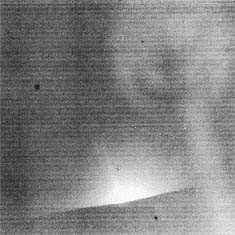
Larger version..

CAPTION
Surveyor 1 Solar Corona Spike "Solar corona in the photograph observed by Surveyor 1, 16 minutes after sunset on the Moon June 14,1966," was remarked Gordon Newkirk, of the High Altitude Observatory. "A bright coronal streamer is visible as a thin pencil of light extending out of the brighter inner corona, against which the lunar horizon is silhouetted."
Surveyor 6 Horizon Glow

CAPTION
67-H-1642 November 24, 1967 - Sunlight diffracted at Moon's limb as seen in Surveyor VI picture of the horizon west of spacecraft.
NOTE: This is the same piture, albeit an early poorer quality version, that Hoagland uses for his 'glass dome' theory
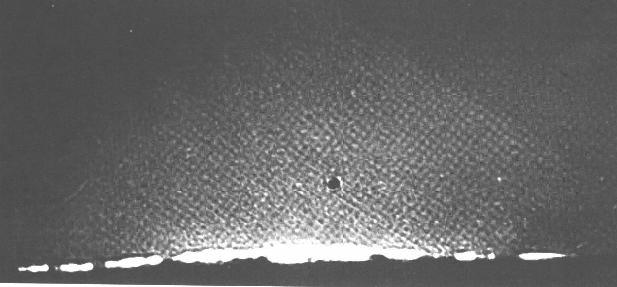
Surveyor 7 Horizon Dust Glows
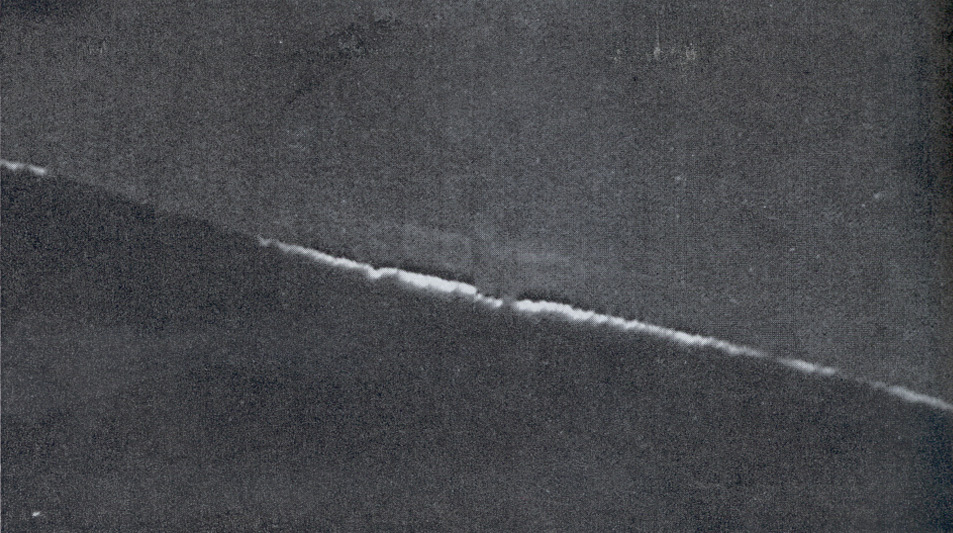
Courtesy NASA/JPL
Illumination along western horizon approximately 15 minutes after local sunset.
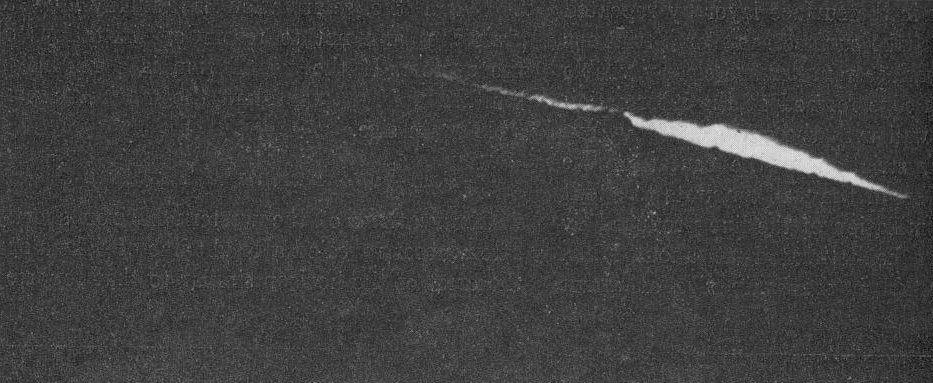
Courtesy NASA/JPL
Illumination along western horizon approximately 90 minutes after local sunset.
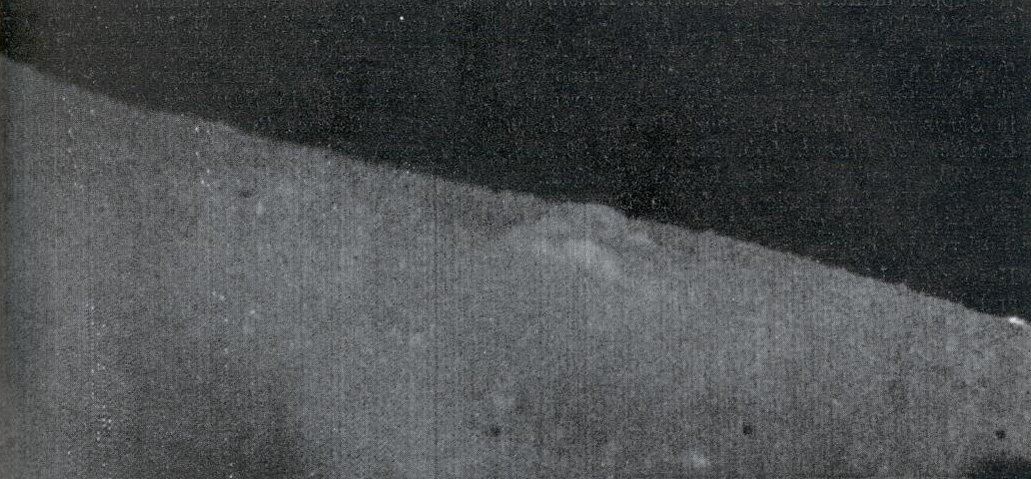
Courtesy NASA/JPL
Same field of view of western horizon about 160 minutes after local sunset.[lit by Earth light]
CONTINUED...
[edit on 3-9-2009 by zorgon]
Surveyor Observations of Lunar Horizon-Glow
J. J. Rennilson1 and D. R. Criswell2
(1) Division of Geological and Planetary Sciences, California Institute of Technology, Pasadena, Calif., USA
(2) The Lunar Science Institute, Houston, Tex., USA
Received: 13 August 1973
Abstract Each of the Surveyor 7, 6, and 5 spacecraft observed a line of light along its western lunar horizon following local sunset. It has been suggested that this horizon-glow (HG) is sunlight, which is forward-scattered by dust grains (~ 10µ in diam, ~ 50 grains cm–2) present in a tenuous cloud formed temporarily (lap 3 h duration) just above sharp sunlight/shadow boundaries in the terminator zone. Electrically charged grains could be levitated into the cloud by intense electrostatic fields (> 500 V cm–1) extending across the sunlight/shadow boundaries. Detailed analysis of the HG absolute luminance, temporal decay, and morphology confirm the cloud model. The levitation mechanism must eject 107 more particles per unit time into the cloud than could micro meteorites. Electrostatic transport is probably the dominant local transport mechanism of lunar surface fines.
This work was supported in part by the California Institute of Technology under Grant NGR 05-002-158, and in part by the Lunar Science Institute, which is operated by the Universities Space Research Association under Contract No. NSR-09-051-001 with the National Aeronautics and Space Administration. This paper is Lunar Science Institute Contribution No. 163.
by J. E. McCoy and D. R. Criswell, Abstracts of the Lunar and Planetary Science Conference, volume 5, page 475, (1974). Another was "Surveyor Observations of Lunar Horizon-Glow" by J. J Rennilson and D. R. Criswell, The Moon 10: 121--142 (1974).
Alternate route
adsabs.harvard.edu...
Surveyor 1

Larger version..

CAPTION
Surveyor 1 Solar Corona Spike "Solar corona in the photograph observed by Surveyor 1, 16 minutes after sunset on the Moon June 14,1966," was remarked Gordon Newkirk, of the High Altitude Observatory. "A bright coronal streamer is visible as a thin pencil of light extending out of the brighter inner corona, against which the lunar horizon is silhouetted."
Surveyor 6 Horizon Glow

CAPTION
67-H-1642 November 24, 1967 - Sunlight diffracted at Moon's limb as seen in Surveyor VI picture of the horizon west of spacecraft.
NOTE: This is the same piture, albeit an early poorer quality version, that Hoagland uses for his 'glass dome' theory

Surveyor 7 Horizon Dust Glows

Courtesy NASA/JPL
Illumination along western horizon approximately 15 minutes after local sunset.

Courtesy NASA/JPL
Illumination along western horizon approximately 90 minutes after local sunset.

Courtesy NASA/JPL
Same field of view of western horizon about 160 minutes after local sunset.[lit by Earth light]
CONTINUED...
[edit on 3-9-2009 by zorgon]
Moon Storms
More from NASA
AH so this answers my question why they didn't snap a picture on the surface
So they all saw this effect...and made sketches... So where are these sketches? And not one photo from the lot?
Moon Storms -- (Science@NASA)
science.nasa.gov...
Dont Breathe the Moondust
NASA needs to start a story with "This is a true story..."
Don't Breathe the Moondust -- (Science@NASA) on the potential toxicity of lunar dust
science.nasa.gov...
More Reading from NASA
The Lunar Ejecta and Meteorite Experiment
ares.jsc.nasa.gov...
Lunar transient phenomena -- or "LTPs."
www.ltpresearch.org...
...This site includes an observing manual
www.ltpresearch.org...
A catalogue of LTPs -- spanning centuries, from 1540 to 1969.
www.mufor.org...
NOTE: This link is now defunct. It was a text version of the report that I linked earlier from Scribd. To bad... it was a lot easier to read... but its funny that NASA links to MUFON
NASA Technical Report TR R-277. was published in July 1968 as a Chronological Catalog of Reported Lunar Events From 1540 to 1966 This is hard to find now but there is a copy available here at Scribd- NASA Technical Report TR R-277
Crackling Planets -- (Science@NASA) on the electrostatic hazards of lunar and Martian dust
science.nasa.gov...
Moon Fountains -- (Science@NASA) describes the "fountain model" of levitating moondust
science.nasa.gov...
Moon Storms -- (Science@NASA)
science.nasa.gov...
Don't Breathe the Moondust -- (Science@NASA) on the potential toxicity of lunar dust
science.nasa.gov...
En Route to Mars, the Moon -- (Science@NASA)
science.nasa.gov...
The Vision for Space Exploration
www.nasa.gov...
So Jim... hope this answers your question
Now be a good chap and get me some of those other sketches from your NASA buddies, will you? Thanks
More from NASA
Moon Storms
12.07.2005
An old Apollo experiment is telling researchers something new and surprising about the moon.
December 7, 2005: Every lunar morning, when the sun first peeks over the dusty soil of the moon after two weeks of frigid lunar night, a strange storm stirs the surface.
The next time you see the moon, trace your finger along the terminator, the dividing line between lunar night and day. That's where the storm is. It's a long and skinny dust storm, stretching all the way from the north pole to the south pole, swirling across the surface, following the terminator as sunrise ceaselessly sweeps around the moon.
Never heard of it? Few have. But scientists are increasingly confident that the storm is real.
What could cause this? Stubbs has an idea: "The dayside of the moon is positively charged; the nightside is negatively charged." At the interface between night and day, he explains, "electrostatically charged dust would be pushed across the terminator sideways," by horizontal electric fields.
AH so this answers my question why they didn't snap a picture on the surface
Astronauts may have seen the storms, too. While orbiting the Moon, the crews of Apollo 8, 10, 12, and 17 sketched "bands" or "twilight rays" where sunlight was apparently filtering through dust above the moon's surface. This happened before each lunar sunrise and just after each lunar sunset. NASA's Surveyor spacecraft also photographed twilight "horizon glows," much like what the astronauts saw.
So they all saw this effect...and made sketches... So where are these sketches? And not one photo from the lot?
Now a new scientific explanation is gaining traction. "It may be that LTP's are caused by sunlight reflecting off rising plumes of electrostatically lofted lunar dust," Olhoeft suggests.
All this matters to NASA because, by 2018 or so, astronauts are returning to the Moon. Unlike Apollo astronauts, who never experienced lunar sunrise, the next explorers are going to establish a permanent outpost. They'll be there in the morning when the storm sweeps by.
The wall of dust, if it exists, might be diaphanous, invisible, harmless. Or it could be a real problem, clogging spacesuits, coating surfaces and causing hardware to overheat.
Which will it be? Says Stubbs, "weve still got a lot to learn about the Moon."
Moon Storms -- (Science@NASA)
science.nasa.gov...
Dont Breathe the Moondust
April 22, 2005: This is a true story.
In 1972, Apollo astronaut Harrison Schmitt sniffed the air in his Lunar Module, the Challenger. "[It] smells like gunpowder in here," he said. His commander Gene Cernan agreed. "Oh, it does, doesn't it?"
The two astronauts had just returned from a long moonwalk around the Taurus-Littrow valley, near the Sea of Serenity. Dusty footprints marked their entry into the spaceship. That dust became airborne--and smelly.
NASA needs to start a story with "This is a true story..."
Don't Breathe the Moondust -- (Science@NASA) on the potential toxicity of lunar dust
science.nasa.gov...
More Reading from NASA
The Lunar Ejecta and Meteorite Experiment
ares.jsc.nasa.gov...
Just one of several papers from the early 1970s hypothesizing that twilight glows
photographed by the Surveyor landers and the "lunar rays" seen by the Apollo 17
astronauts were due to suspended lunar dust was "Evidence for a Lunar Dust
Atmosphere from Apollo Orbital Observations" by J. E. McCoy and D. R. Criswell,
Abstracts of the Lunar and Planetary Science Conference, volume 5, page 475, (1974).
Another was "Surveyor Observations of Lunar Horizon-Glow," by J. J Rennilson and D. R.
Criswell, The Moon 10: 121--142 (1974). More recently, the Clementine spacecraft also
recorded strange glows along the lunar limb.
Lunar transient phenomena -- or "LTPs."
www.ltpresearch.org...
...This site includes an observing manual
www.ltpresearch.org...
A catalogue of LTPs -- spanning centuries, from 1540 to 1969.
www.mufor.org...
NOTE: This link is now defunct. It was a text version of the report that I linked earlier from Scribd. To bad... it was a lot easier to read... but its funny that NASA links to MUFON
NASA Technical Report TR R-277. was published in July 1968 as a Chronological Catalog of Reported Lunar Events From 1540 to 1966 This is hard to find now but there is a copy available here at Scribd- NASA Technical Report TR R-277
Crackling Planets -- (Science@NASA) on the electrostatic hazards of lunar and Martian dust
science.nasa.gov...
Moon Fountains -- (Science@NASA) describes the "fountain model" of levitating moondust
science.nasa.gov...
Moon Storms -- (Science@NASA)
science.nasa.gov...
Don't Breathe the Moondust -- (Science@NASA) on the potential toxicity of lunar dust
science.nasa.gov...
En Route to Mars, the Moon -- (Science@NASA)
science.nasa.gov...
The Vision for Space Exploration
www.nasa.gov...
So Jim... hope this answers your question
Now be a good chap and get me some of those other sketches from your NASA buddies, will you? Thanks
Clementine Limb Glow Shots
Search for Horizon Dust
by David O. Darling
The following images are from the NAVY Clementine orbiter. The stars are visible and the bright object is Venus

LBA5881Z Clementine Star Tracker Camera (N.A.S.A.)

LBA5883Z Clementine Star Tracker Camera (N.A.S.A.)

LBA5884Z Clementine Star Tracker Camera (N.A.S.A.)

LBA5885Z Clementine Star Tracker Camera (N.A.S.A.)

STA 552 Clementine Image (N.A.S.A.)
David's material reprinted by permission
Also more glow shots from Clementine here
www.thelivingmoon.com...
Search for Horizon Dust
by David O. Darling
Depending on what Clementine images you view, you can see dust streamers extending off the limb of the Moon. The images displayed show this phenomena, The other group of shots that show the same lunar limb but is over powered by the intense brightness of the solar corona. See Corona. Other examples of the limb glows or horizon glows can be found at these two sites: Dust and Zodiacal lights
Close examination of the photograph below give strong indications of dust along the lunar limb. You can see along the entire edge of the disk regions that appearance knotted and swirled faint luminescence.
The following images are from the NAVY Clementine orbiter. The stars are visible and the bright object is Venus

LBA5881Z Clementine Star Tracker Camera (N.A.S.A.)
This photograph continued decline of solar illumination but you can still see the faint glowing cloud along the entire edge of the lunar disk.

LBA5883Z Clementine Star Tracker Camera (N.A.S.A.)
With this photograph you can still see that the illumination along the lunar disk still remain in an illuminated state. The glowing area is most prominent along the mid section of the lunar limb.

LBA5884Z Clementine Star Tracker Camera (N.A.S.A.)
The final photograph shows that the illumination along the limb continues to glow faintly along the entire lunar limb.

LBA5885Z Clementine Star Tracker Camera (N.A.S.A.)
"This Startracker image shows the Moon eclipsing the Sun. The bright crescent Earth is partially visible at left, saturating the sensor. The image was captured during orbit 164, on March 26, 1994, halfway through Moon mapping at a distance of 3500 km."
This image of the Moon's limb very well defined but again it is over saturated by the intensity of the solar corona.

STA 552 Clementine Image (N.A.S.A.)
David's material reprinted by permission
Also more glow shots from Clementine here
www.thelivingmoon.com...
That's why the old idea of putting a telescope on the Moon's far side was such a bad idea. The extent of levitated dust was simply not predicted.
So when instruments and astronauts noticed the unexpected phenomenon, they published their results and began new observations.
You have an issue with that?
So when instruments and astronauts noticed the unexpected phenomenon, they published their results and began new observations.
You have an issue with that?
Great topic, I'm a little puzzled Zorgon why you are cynical about the Nasa explanation, wouldn't solar winds alone cause dust from the moon's
surface to be lifted into space? The moon is purely static, couldn't moon quakes coupled with the moons tenuous magnetic poles also propel some dust
into a very low and temporary orbit? I wouldn't be surprised if escaping atmosphere from the earth found it's way into the moon's gravity well,
although it's probably also blown away by solar winds.
At any rate, great pics.
At any rate, great pics.
So John Lear was right! The moon does have an atmosphere "Awesome!"
Originally posted by Phage
Where are the Aliens?
Where are the UFOs?
Well mods are free to move the thread... I suppose 'Space Sciences' might be more appropriate... I just clicked 'new thread' where I replied
Perhaps you could evoke the Mod Gods to make it so...
Three stars for that comment? That the best answer you got?
simply amazing
:shk:
[edit on 3-9-2009 by zorgon]
Originally posted by frankensence
Great topic, I'm a little puzzled Zorgon why you are cynical about the Nasa explanation,
I am not cynical about their explanation... I am cynical that it took them this long to publicly state that there are dust clouds on the Moon... whatever the reason. All these years people have been called crazy for saying just that... astronomers who spotted it didn't report it for fear of what their peers would say
Now suddenly their scientists are using terms like atmosphere, moon dust and dust storms...
Makes you ask... what else will they tell us years from now?
And of course the skeptics will come in saying "Well this makes sense..." Yet not one of those ever offered t as a viable explanation, nor created a thread on it when its been on NASA science since 2005... and know about since Surveyor
Cynical? Me?
Electrostatically levitated dust on the moon has been widely discussed since, oh, about 1964 or so. The fact that you're only now catching on is no
evidence that 'NASA wasn't talking about it,' it's more evidence for
[insert your favorite phrase here]
You started the post on the other thread because you apparently were under the bizarre misimpression that the astronauts had made those sketches while they were in spacesuits out on the lunar surface.
That WAS your misimpression, right?
[insert your favorite phrase here]
You started the post on the other thread because you apparently were under the bizarre misimpression that the astronauts had made those sketches while they were in spacesuits out on the lunar surface.
That WAS your misimpression, right?
Originally posted by JimOberg
That WAS your misimpression, right?
No I assumed they did it from the LEM either looking out of the window or from memory. Those clunky suits are not much use for anything.
My POINT was why no one just picked up a camera... I mean they took other images from the Command module right?
Since 1964 huh? Funny then how no one used that as a defense for all those people who were told they were crazy for spotting dust clouds on the moon all these years
reply to post by zorgon
Suddenly?
www.agu.org...
www.windows.ucar.edu...=/earth/moon/lunar_atm.html&edu=high&portal=vocals
www.tsgc.utexas.edu...
www.lpi.usra.edu...
www.sciencedaily.com...
and the list goes on.
You've talked about it often enough too and each time you talk about it like it's been a big secret. The "atmosphere" and the "dust storms" have not been a secret.
[edit on 9/3/2009 by Phage]
Now suddenly their scientists are using terms like atmosphere, moon dust and dust storms...
Suddenly?
www.agu.org...
www.windows.ucar.edu...=/earth/moon/lunar_atm.html&edu=high&portal=vocals
www.tsgc.utexas.edu...
www.lpi.usra.edu...
www.sciencedaily.com...
and the list goes on.
You've talked about it often enough too and each time you talk about it like it's been a big secret. The "atmosphere" and the "dust storms" have not been a secret.
[edit on 9/3/2009 by Phage]
1st picture is really beautiful. ive only seen something like that from computer generated wallpapers.
Originally posted by PhageThe "atmosphere" and the "dust storms" have not been a secret.
Well just go back over the posts and replies here over the past few years and show:
A) How many skeptics have acknowledged the fact that there is atmosphere and dust storms on the moon;
B) How many 'viewers' here are aware of this non hidden truth;
C) How many from the skeptical side of things have posted threads volunteering these facts that have been 'known' since 1964ish
OH and BTW thank you for being true to form and a prime example of my signature
"All truth passes through three stages. First, it is ridiculed. Second, it is violently opposed. Third, it is accepted as being self-evident." - Arthur Schopenhauer
I see you are well into stage three...
From your links... (Thanks but you COULD have done a Lunar Atmosphere Thread... coming from YOU that would have been interesting )
Stern, S. A. (1999), The Lunar Atmosphere: History, Status, Current Problems, and Context, Rev
www.agu.org...
The Lunar Atmosphere
January 5, 1998
LPI
Characteristics of the Lunar Environment
Calina C. Seybold
[email protected]
August 1995
www.tsgc.utexas.edu...
Science Experiments - Lunar Atmospheric Composition
©Lunar and Planetary Institute, 2009
www.lpi.usra.edu...
Investigating The Moon's Atmosphere
ScienceDaily (Aug. 20, 1998)
www.sciencedaily.com...
Seem 1998 before it was talked about openly... So that is only 20 plus years later
[edit on 3-9-2009 by zorgon]
reply to post by zorgon
Dry, boring facts don't seem to raise much interest and I don't go in much for sensationalizing or putting threads in the wrong forum.
Keep looking, you'll find early papers.
[edit on 9/3/2009 by Phage]
Dry, boring facts don't seem to raise much interest and I don't go in much for sensationalizing or putting threads in the wrong forum.
Keep looking, you'll find early papers.
[edit on 9/3/2009 by Phage]
Is that really a fact?
Originally posted by zorgon
A) How many skeptics have acknowledged the fact that there is atmosphere and dust storms on the moon;
And wasn't that "atmosphere" a way of describing the way the dust was suspended, meaning that the dust was the atmosphere and not that the dust was in an atmosphere? That was the idea I got from the text you posted.
PS: sceptics do not acknowledge anything, they (we) just doubt less.
Originally posted by zorgon
Originally posted by JimOberg
That WAS your misimpression, right?
No I assumed they did it from the LEM either looking out of the window or from memory. Those clunky suits are not much use for anything.
My POINT was why no one just picked up a camera... I mean they took other images from the Command module right?
OK, thanks.
That means you thought the men were still on the lunar surface at sunset?
Let's see, the moon's "day" is 30 earth days long.
They landed early in the local "morning" to provide good shadowing of relief on the surface, to aid in their piloting during final descent.
They then would have to stay around about another ten Earth days to wait for sunset. Then they could have seen sunset and sketched the 'rays'.
All official NASA records claim they never stayed more than three days, and were back on Earth within a week.
How do we resolve this conflict of memories?
new topics
-
New Bombshell Evidence Strongly Suggests Trump was Set Up in Classified Docs Saga
US Political Madness: 30 minutes ago -
One More Night at the Pig and Blanket (Time 2024)
Short Stories: 3 hours ago -
Expert Says Parents Should Ask Babies Permission to Change Nappies.
General Chit Chat: 4 hours ago -
Hard evidence of a Royal plot on the US....if only i had proof.
ATS Skunk Works: 5 hours ago -
Do you name your cars ?
General Chit Chat: 6 hours ago -
Jim Biden Was in Business with Qatari Officials
US Political Madness: 8 hours ago -
I may have had a talk with Pope Francis about his plans for our nation
The Gray Area: 8 hours ago -
Sleep paralysis and the implantation of some weird Matrix-esque demon creature...
The Gray Area: 9 hours ago -
Say his name
US Political Madness: 10 hours ago -
There is no such thing as moonlight.
General Chit Chat: 11 hours ago
top topics
-
5 probed after 18-year old girl dies as a result of having the COVID jab
Diseases and Pandemics: 12 hours ago, 19 flags -
Say his name
US Political Madness: 10 hours ago, 17 flags -
Jim Biden Was in Business with Qatari Officials
US Political Madness: 8 hours ago, 12 flags -
Official denial
Diseases and Pandemics: 15 hours ago, 11 flags -
Expert Says Parents Should Ask Babies Permission to Change Nappies.
General Chit Chat: 4 hours ago, 10 flags -
Sleep paralysis and the implantation of some weird Matrix-esque demon creature...
The Gray Area: 9 hours ago, 8 flags -
Hamas and Other Islamist Terrorist Groups Announce Support of US Campus Anti-Israel Protests
Education and Media: 16 hours ago, 8 flags -
MEGA - Let's Make Europe Great Again
Other Current Events: 15 hours ago, 7 flags -
I may have had a talk with Pope Francis about his plans for our nation
The Gray Area: 8 hours ago, 6 flags -
Psychotronic Operation Rwanda Who Wants To Be A Refugee?
ATS Skunk Works: 16 hours ago, 6 flags
active topics
-
Expert Says Parents Should Ask Babies Permission to Change Nappies.
General Chit Chat • 32 • : randomtangentsrme -
Gov Kristi Noem Shot and Killed "Less Than Worthless Dog" and a 'Smelly Goat
2024 Elections • 128 • : Vroomfondel -
SETI chief says US has no evidence for alien technology. 'And we never have'
Aliens and UFOs • 81 • : anthelion -
University of Texas Instantly Shuts Down Anti Israel Protests
Education and Media • 389 • : HopeForTheFuture -
Sleep paralysis and the implantation of some weird Matrix-esque demon creature...
The Gray Area • 10 • : randomuser2034 -
New Bombshell Evidence Strongly Suggests Trump was Set Up in Classified Docs Saga
US Political Madness • 1 • : RazorV66 -
-@TH3WH17ERABB17- -Q- ---TIME TO SHOW THE WORLD--- -Part- --44--
Dissecting Disinformation • 722 • : Crazierfox -
Say his name
US Political Madness • 33 • : Astrocometus -
There is no such thing as moonlight.
General Chit Chat • 20 • : NoviceStoic4 -
Jim Biden Was in Business with Qatari Officials
US Political Madness • 55 • : xuenchen


